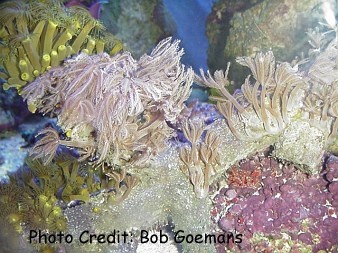
By Bob Goemans

Likely Reef Tank Suitable
Likely Fish-Only Tank Suitable
Range: Indo-West Pacific Ocean
Natural Environment: This is an encrusting photosynthetic soft coral that generally inhabits protected, fairly shallow nutrient rich back reef areas where gentle currents exist. Its cylindrical-shaped polyps, tall, about 5 inches (12 cm), are part of an encrusting base that usually encompasses dead coral rubble and hardpan areas. Polyps have 8 delicate pinnate tentacles, which have been seen to rhythmically open and close (pulse) in the wild. The most common color is a rich brown, however, however, other colors such as ashen grey, and/or very light tan specimens have also been seen.
General Husbandry: This soft coral is often confused with Xenia, which is similar in appearance. Whereas Xenia polyps extend from its stalk or branches, the larger Anthelia polyps arise directly from its encrusting base, which is a good way to tell these two favorites apart from each other.
Furthermore, Xenia is usually purchased because its polyp's tentacles have the capacity to pulse at regular intervals. Even though Anthelia polyp tentacles are also said to pulse in the wild, yet far less than do Xenia polyps, their pulsing in aquaria is quite infrequent. It is thought the pulsing tends to move dissolved organic laden water past the tentacles and/or is a form of respiration where dangerously high levels of dissolved oxygen are dissipated. One thing for sure, the reason for pulsing is still conjecture.
Nevertheless, its appears Anthelia does not need any specific direct feeding method, therefore, only needs to be placed in a well lighted area and where water quality is somewhat nutrient rich and gentle flows exist. There are those that recommend activated carbon not be used, or at least, its use limited in aquaria containing this species. The same is true for Xenia, as it may affect their growth simply because this product lowers the aquarium's nutrient content. Personally, I have not found this to be true, as those specimens, both Anthelia and Xenia in my aquaria did extremely well in systems where water quality was 'excellent' and nitrogen-laden products where for all practicable purposes below what could be read on hobbyist test kits.
And even though Anthelia does not seem to contain any toxic chemicals, therefore, extremely compatible with other type corals it touches, it can spread quite fast under the right circumstances. Therefore it's wise to provided enough surrounding space for growth, as it can 'simply' overgrow its neighbors.
Taxonomy:
Kingdom: Animalia
Phylum: Cnidaria
Class: Anthozoa
Subclass: Octocorallia
Order: Alcyonacea
Family: Xeniidae
Genus: Anthelia
FYI: Do not remove a specimen with highly inflated polyps from the water as the weight of the water in the flesh may damage/tear the polyps. Gently shake the specimen and allow them to retract somewhat before removing.
Even though this species is a poor shipper, healthy specimens, once established are quite hardy and disease resistant.
Mariculture specimens available in the trade/Easily cultivated from cuttings.
Experience Level: Beginner
Diet: Photosynthetic/Absorption of nutrients
Temperament: Peaceful
Aquarium Environment: Reef or fish-only aquarium
Coral Safe:Yes
Fish Safe: Yes
Invertebrate Safe: Yes
Acclimation Time: 30 minutes+
Aquarium Hardiness: Hardy
Calcium (Ca): 380 - 430 mg/l
Alkalinity: 2.5 - 3.0 meq/l
Phosphate (PO4): <0.05 mg/l
Magnesium (Mg): approx. 1350 mg/l (relate to specific gravity)
Strontium (Sr) 8 - 10 mg/l
Temperature Range: 72 - 83°F (22 - 28°C)
Minimum Tank Size: 50 gallons
Lighting: PAR 300 - 450+
Water Movement: WM 1 - 2
Specific Gravity: 1.023 - 1.025
pH: 8.0 - 8.4
Iodine/Trace Elements Monitor/as necessary to maintain quality seawater.
